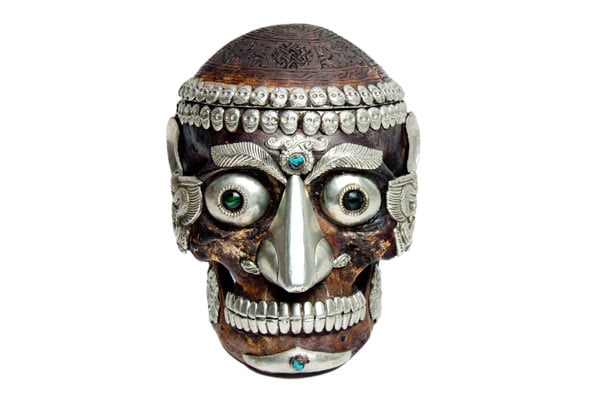The practices and rituals of Tibetan Kapala skull caps
The word Kapala is a Sanskirt term meaning skull, bowl, vessel, begging bowl and is a decorative human skull used as a ritual implement in both Hindu and Buddhist Tantra. They were often carved with decorative designs or elaborately mounted with precious metals and jewels. There are two main types of kapalas – those that use a full skull, and those that only use the skull cap or top-half of the cranium.
The kapalas were usually made from skulls collected at sky burial sites, an ancient Tibetan burial custom, still practiced today, in which the bodies of the dead are dismembered and scattered over open ground to ‘give alms to the birds’. It is a ritual that has a great religious meaning of the ascent of the soul to be reincarnated into another circle of life.
Once collected, the skulls would be specially prepared and elaborately anointed and consecrated before use. It would then be decorated with carvings, jewels of silverwork before being used as a ritual implement.
In Tibetan monasteries, the kapala was used to hold dough cakes or wine, used symbolically as flesh and blood offerings to wrathful deities of Hindu India and Buddhist Tibet. When symbolising blood it is called Asrk Kapala, and when with flesh it is called Mamsa Kapala. The dough cakes were not just pieces of bread, but were shaped to resemble human eyes, ears and tongues.
The skull cup, when used as libation to gods and deities to win their favour, is usually held in the left "wisdom" hand and held in front of a deity's heart where it may be paired with such right hand 'method' implements such as the vajra or curved knife. Many wrathful deities hold a curved knife above a skull cup in front of their hearts symbolizing the union of their method and wisdom. The Hindu goddess Kali, for example, is often depicted holding or drinking from a blood-filled Kapala. The curved knife serves as the "method" weapon that severs the life and vital organs of demonic enemies and the skull cup is the "wisdom" vessel in which the blood and organs are collected as the deity's life source.
Kapalas were also used in rituals like higher tantric meditation to achieve a transcendental state of thought and mind within the shortest possible time, as offering bowls on the altar or as eating or drinking bowls. It was believed that the people who drank out of the skull caps would obtain the knowledge and personality from the person to whom the skull belonged. The use of a human skull as a drinking cup in ritual use or as a trophy is reported in numerous sources throughout history and among various peoples, and among Western cultures is most often associated with the historically nomadic cultures of the Eurasian steppe
The skulls were often regarded as "karmic vessels" which contain the good and bad qualities of the dead person. The karmic force of the dead is believed to be still alive in the skull and thus will infect living beings on touch. Therefore, it is said that only with the proper religious instruction and Tantric transmission one is able to make skilful use of the power of skulls and avoid harm caused by bad karma associated with the skull.
Depending on the purpose, the kapalas would contain such substances as: divine nectar (Skt. amrita), vital nectar (semen), alcohol, ritual cakes or tormas, fresh blood, marrow, intestines, fat, as well as the brains, heart and lungs of demonic enemies.
Although the skulls were once used for spiritual purposes and to achieve higher states of consciousness, like many other traditions there are cases of the rituals being adulterated to suit the purposes of cults and for use in the ‘dark arts’. For example, there are cases of kapalas being produced after the murder or ‘sacrifice’ of a victim followed by the eating of their flesh. The skull of a child who died during the onset of puberty was believed to have great potency as would the "misbegotten skull" of a 7-8 year old child born from an incestuous union. The sectioning of skulls also carried certain meanings. For example, a one-sectioned skull are those of highly realized persons, which a skull with six or more sections represents illness and would be used in ‘destruction mantras’.
Many carved and elaborately mounted kapalas survive today, mostly in Tibet.
Links
Video




















Comments
The dark colored full skulls are not smoked. Rather it is part of the patina and silver embellishing process/carving. Depending on what method is used, some craftsmen tend to use firing which will cause the “blackened” finish. Bees wax is used to hold the silver stamping (embellishments) in place. This also requires heating. Some of the newer “tourist” collector’s skulls are polished and gloss coated to remove the blackened patina. I have quite a few full skulls in my collection.
I am very familiar with Kapalas and skull caps in general. I have seen many variations from later pieces having marbles as eyes, older pieces containing semi precious stones for eyes, and many with a neck "collar" adorned with earrings. One thing that has struck me is a Kapala who's actual complete facial skull appears to have been painted black (or smoked?). I've seen many skull caps painted with scenes, but never the actual entire skull, let alone in one solid color (black).
Are you familiar with this and do you know it's purpose? Any information would be greatly appreciated.